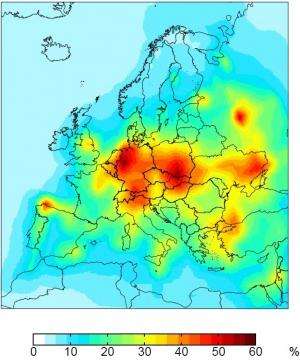Counting the cost of mercury pollution

Cleaning up mercury pollution and reducing prenatal exposure to the neurotoxin methylmercury (MeHg) could save the European Union €10,000 million per year, finds a new study published in BioMed Central's open access journal Environmental Health. New estimates suggest that between 1.5 and 2 million children in the EU are born each year with MeHg exposures above the safe limit of 0.58µg/g and 200,000 above the WHO recommended maximum of 2.5µg/g.
While some mercury occurs naturally in the environment for example from volcanic eruptions or forest fires, most is generated by burning fossil fuels. Marine and fresh water species bioconcentrate MeHg; consequently the main source of exposure for humans is from eating fish.
A team of researchers from across Europe used the DEMOCOPHES study of exposure to environmental chemicals to assess the impact of MeHg on humans. Hair samples of child-mother pairs, collected from 17 European countries, demonstrated that, as a lower estimate, 1,866,000 children are born in Europe exposed to toxic levels of MeHg. 232,000 of these are exposed to hazardous levels, five times higher. But not every child in Europe is equally at risk. When analysed per country, children born in Portugal and Spain were the most exposed to MeHg, and Hungary the least.
Exposure to MeHg in humans affects brain development, resulting in a lower IQ, and consequently a lower earning potential. The long term cost to society can be calculated as lifetime earning loss per person, although this estimate does not take into account other aspects of brain toxicity or risks of cardiovascular disease in adults.
Prof Philippe Grandjean explained, "If we convert the effects of MeHg on developing brains into IQ points then the benefits of controlling MeHg pollution equates to 700,000 IQ points per year and monetary benefits of €8,000 to €9,000 million per year for the whole of the EU. Exposure abatement would mainly benefit southern Europe ."
Once MeHg is formed, it cycles though the environment for thousands of years, exposing humans and other species to potentially toxic levels for generations. Commenting on the research Dr Elsie Sunderland said, "Mitigating the harm caused by methylmercury requires global-scale cooperation on policies and source reductions. Negotiations by the United Nations Environment Program are currently underway to address mercury emission levels."
More information: Economic benefits of methylmercury exposure control in Europe: Monetary value of neurotoxicity prevention, Martine Bellanger, Céline Pichery, Dominique Aerts, Marika Berglund, Argelia Castaño, Mája Čejchanová, Pierre Crettaz, Fred Davidson, Marta Esteban, Marc E. Fischer, Anca Elena Gurzau, Katarina Halzlova, Andromachi Katsonouri, Lisbeth E. Knudsen, Marike Kolossa-Gehring, Gudrun Koppen, Danuta Ligocka, Ana Miklavčič, M. Fátima Reis, Peter Rudnai, Janja Snoj Tratnik, Pál Weihe, Esben Budtz-Jørgensen, Philippe Grandjean, Environmental Health (in press)
Commentary: Future trends in environmental mercury concentrations: implications for prevention strategies, Elsie M Sunderland and Noelle E Selin, Environmental Health (in press)
Journal information: Environmental Health
Provided by BioMed Central















